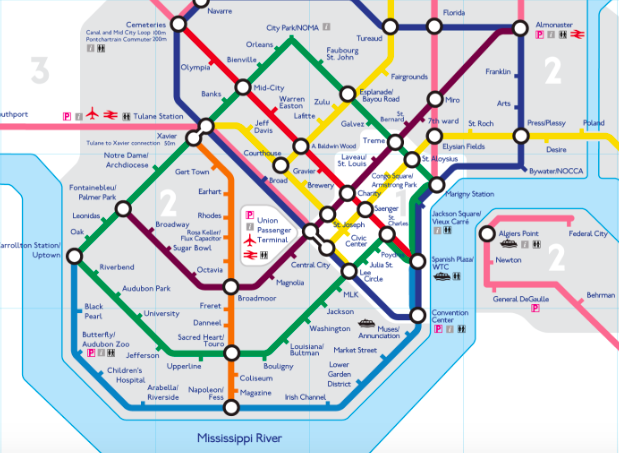
Ride New Orleans’ vision for the future of public transport in the city
London’s public transport has been central to the city’s identity in modern times – think of red double-deckers, Hackney cabs, and the Tube, whose presence in London’s idea of itself can be traced back as far as Sherlock Holmes. And as the use of the Tube by the fictional detective suggests, the Tube and other public transport systems have long been part of London’s cultural landscape in their own right and are not merely linking mechanisms between its points of interest.
Then there is also of the popularity of alternative tube maps. I have a collection of these that includes the Tube in tinsel, an Underground map where station names are replaced by smells, and a map with “real” distances, which Londoners find silly and unreal.
The Tube map is also used by cartographers here and elsewhere to represent other networks of significance: relationships between philosophers; the Milky Way; or the global network of fibreoptic cables that the internet relies on. All this suggests that the Tube is not just a transport network but a shared internal logic for Londoners, a deep structure for which they instinctively reach.
There is usually little evidence, however, that public transport might represent anything collective on your average Tube or bus journey, where passengers tend to remain resolutely in their individual worlds. In his great poem The Waste Land, T. S. Eliot said of commuters walking over London Bridge: “I had not thought death had undone so many./Sighs, short and infrequent, were exhaled,/And each man fixed his eyes before his feet.”
One person set out to change this recently by producing “Tube chat?” badges, or buttons if you like, to get Londoners to talk to each other on public transport. It may be relevant that this person is an American – in my experience, people from the US are generally far more willing than Brits, and especially Londoners, to talk to strangers.
People in New Orleans can certainly be highly commended for their willingness to strike up a chat, on public transport and elsewhere. But while the city has some notable examples of useful and beloved public transport facilities – for example, the St. Charles streetcar, or the ferry to Algiers – the city, in thrall to the car for too long like many in America, could do better on this front. Public transport campaigning group Ride New Orleans in particular is doing much to bring about change (see the map above for their vision for the future of the city’s public transport).
The opportunity to talk to people you wouldn’t normally encounter is just one small aspect of the importance of good public transport to cities, which brings shared social, cultural, environmental and economic benefits that stretch far beyond the simple convenience of being able to get from A to B. Some cities need help with communication, some with commuting, but the more we all do to nurture our public transport networks and what they can do for cities, the better.

